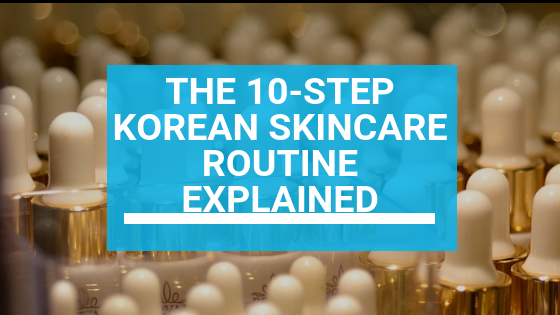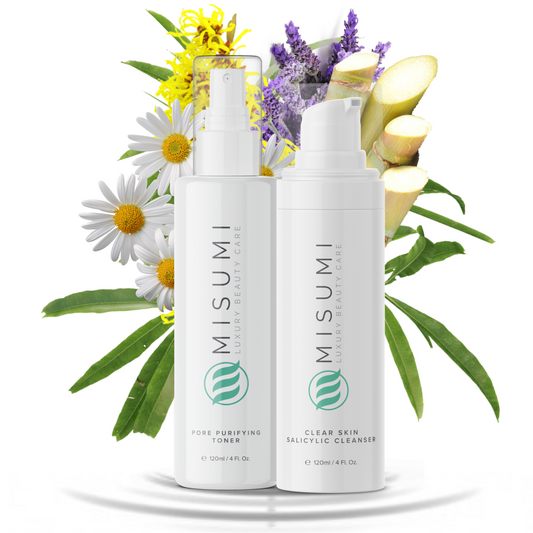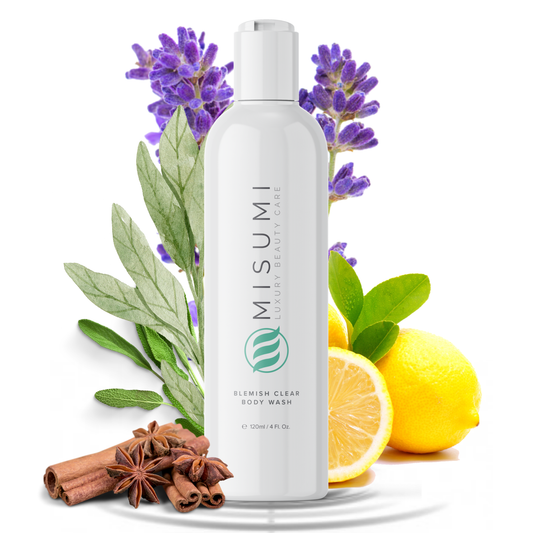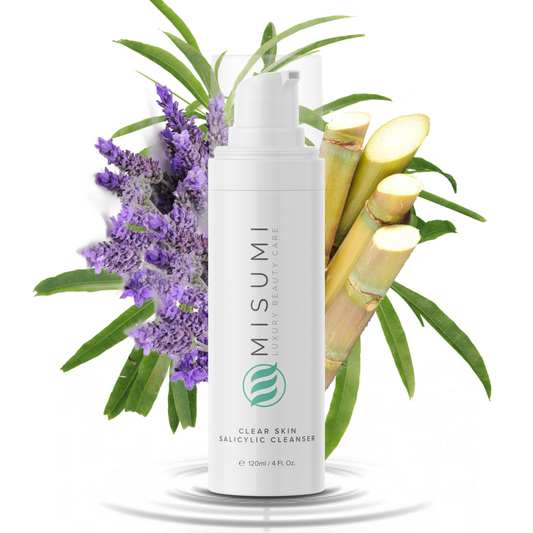Does a 10-step skincare routine sound extreme to you? Don't worry; you're not the only one.
Even though Korean skincare is a hot topic in the skincare community, many people find this extensive skincare routine very intimidating. Some deem it time-consuming, while others feel they don't need to pay that much attention to their skin. However, many people swear this routine has improved their skin health.
In this article, you'll discover exactly what the 10-step Korean skincare routine entails. We'll go into the precise details of every step, and you can judge for yourself whether or not this skin care routine is worth a try.
What Exactly is the 10-step Korean Skincare Routine?
Continue reading to find out what each step does for your skin.
Step 1: Oil Cleansing

The very first step of the Korean skin care routine is oil cleansing. Korean skincare stresses the importance of using a suitable oil cleanser to remove makeup. You can use a store-bought version of an oil-based cleanser or choose non-comedogenic, organic, cold-pressed oils that won't clog pores. Examples include jojoba oil and rosehip oil.
Gently massage the oil-based cleanser into your skin and wash it off. Then, you can follow it up with the second step.
If you have oily skin, you may want to stay away from oil-based cleansers, but you can always use another cleanser to clean your skin, such as a water-based cleanser. We recommend the Clear Skin Salicylic Cleanser.
Step 2: Regular Cleansing
For the second step, use your normal cleanser.
The best cleanser for you depends largely on your skin type. If you have oily or acne-prone skin, stick to gel cleansers that won't upset your skin barrier. Dry skin types should use a milk cleanser that resembles a lotion.

Using a regular cleanser after removing your makeup with an oil-based cleanser will ensure all the impurities sitting on your face are washed off. This minimizes the chances of dealing with clogged pores and any acne or congestion that might come from it.
If the oil cleanser doesn't remove all the makeup, dirt, and bacteria, this second cleanse will get rid of the residue, making sure your skin has been cleansed properly.
Double cleansing might not be for everyone, so do your research before implementing it.
Step 3: Exfoliating
We generally think of exfoliating as a practice we employ only a few times a week, but some Korean people do it as much as once a day!
This step is essential in helping us get rid of clogged pores, which are dangerous for the skin, for many different reasons. Not only will clogged pores make your complexion look lifeless and dull, but not exfoliating can also lead to serious skin conditions such as acne. Exfoliation will remove dead skin cells, hair, and debris that end up clogging the pores.
You can get both physical and chemical exfoliators. Each has different pros and cons, but both are designed to help you optimize the appearance of your skin and make it soft and glowing.

However, it's important to mention the dangers of over-exfoliation.
Over-exfoliation can lead to some serious side effects, such as damage to your protective skin layer, causing dry and irritated skin. This is why the Korean skincare routine won't work for all skin types. It's up to you to decide whether or not you try it out. Make sure to monitor how your skin reacts to this step in particular.
If you don't want to exfoliate daily but still want to use exfoliation as part of your routine, stick to doing it once to twice weekly. This way, you'll see good results without causing unnecessary damage to your skin's barrier.
Step 4: Toner
Not everyone understands what toners are made to do for our skin, and we're not surprised. There are so many steps and products in the skincare world that it's hard to keep track of all of them. On top of that, the functions of products often overlap, especially if they have similar formulas and appearances.
There are many reasons why you should add a toner to your daily skincare regimen. Toners are designed to remove excess makeup and oil that's been sitting on top of our skin, helping you avoid nasty breakouts. Toners also help the skin maintain its proper pH balance. It can even work as a preventative measure against acne for some people.

Make sure you choose a good toner for your skin type, and then use a cotton pad to apply.
Stick to an alcohol-free toner since alcohol tends to dry out our skin. If you have dry skin, pay special attention to your toner's ingredients list. Make sure to choose natural and gentle ingredients whenever possible, especially if you have specific skin concerns like acne. We recommend the Pore Purifying Toner.
Step 5: Essence
Essence is one of the most important steps in Korean skincare.
Think of it as a primer for your moisturizer. In short, an essence is a lightweight, moisturizing liquid that helps your skin attain all the hydration it needs from the moisturizer that follows it.
On top of that, essence also has the power to speed up cell turnover, which is an incredible benefit if you have any kind of skin damage, whether it's hyperpigmentation or scars.
Essence is easy to use and implement in any skincare routine. Even if you decide that the 10-step Korean skincare routine isn't for you, your skin can still benefit from using essence.
Put a few drops on your palms and press it on your face until it's absorbed into the skin.

There are a lot of essence products on the market, so the one you choose will largely depend on your skin type. If you have dry skin, use an essence whose function is to moisturize properly. If you have oily skin, use one specifically designed for oily skin that won't look too greasy. If your complexion needs a little pick-me-up, use a radiance-booster essence to make your face look lively and flawless.
Step 6: Treatments
All of us have different skin issues to deal with. Treatments come in all shapes and sizes, the most notable of which are serums, ampoules, and boosters. By using these, you're targeting specific skin concerns.
This step should tackle any issue, whether it's aging or acne. Whatever problem you're facing, chances are you'll be able to find a treatment for it. It might take longer for you to see results, but the process is worth it.
All the above-mentioned treatments are packed with active ingredients beneficial for your skin, such as tea tree and vitamin C.
Step 7: All About the Masks

A good old sheet mask is the perfect addition to any pamper day.
Sheet masks are not only designed to be fun, but they're also packed with good ingredients that will do wonders for your skin. Not only that - they're easy to use and find.
Some people prefer to use sheet masks two to three times a week. However, Korean women like to pamper themselves frequently, which is why a mask is a daily occurrence for them. If you have dry skin, you might be able to get away with doing them more often.
By applying a mask that sits on your skin for a longer period, you're forcing your skin to absorb all the goodness from it. The best part is that step 7 is one of the easiest on the list. Each sheet mask comes with a particular instruction – all you need to do is apply it directly on top of your skin and let it sit for around 15 to 20 minutes.
When you remove the mask, pat the remaining product on your face for extra nourishment. And after those 20 minutes are done, your skin will look softer and brighter than ever!
There are so many sheet masks to choose from, and it can be overwhelming if you're new to skincare. The basic rule of thumb is this: stick to masks designed for your particular skin type.
Daily masks aren't for everyone, and sheet masks can be time-consuming. This is why some people often skip this step.
Step 8: Eye Cream

Why is applying eye cream so important? Wouldn't a regular moisturizer suffice? The answer is no.
The skin around your eyes is delicate and vulnerable, so it needs special attention. By applying a moisturizing eye cream under your eyes and on your eyelids, you're hydrating the area, helping your makeup sit better, and protecting your skin from premature wrinkles and fine lines.
The eye cream you choose will depend on your skincare goals. If you only want to hydrate the skin, choose an eye cream designed for that purpose. If you want to treat dark circles and bags under the eyes, you can find creams targeting those specific problems.
Apply eye cream with your ring finger. Gently dab it under your eyes and on your lids. Avoid getting any eye cream in your eyes.
Step 9: Moisturizer
Choosing the right moisturizer for your skin is not an easy task. If you want some help in that department, feel free to check out this article.
A moisturizer should hydrate your skin without making it feel or appear greasy. We all want that dewy, healthy finish.

If you're wondering why this step is among the last, it's because moisturizer forms a thicker layer across the skin than other previously mentioned products. The idea is to gradually increase the thickness of the products you use on your skin.
You should always adjust the moisturizer to your skin type. Even people with oily skin should include this step in their day-to-day skincare. If, by any chance, you want to treat signs of aging, our best-selling wrinkle-free moisturizer is an incredible option!
Step 10: Sun Protection
How many times have you heard about the importance of incorporating sunscreen in your skincare regimen?
The sun is extremely damaging to the skin, and unprotected sun exposure can lead to all kinds of skin problems, such as hyperpigmentation and premature signs of aging. Not to mention, it's also been linked to skin cancer.

To avoid this, use an SPF that protects from UVB and UVA rays. Make it the last step in your routine, and feel free to follow it up with makeup or BB cream.
Even if you're just going out in the sun for a couple of minutes, make applying sunscreen a habit. If you're out for a longer period, reapply sun protection every 20 to 30 minutes, especially if you're in and out of water.
Can Everyone Benefit from the 10-step Korean Skincare Routine?
Every skin is different. There's no way to determine if your skin will agree with this extensive list of products.
One thing is certain – the 10-step Korean skin care routine contains some crucial steps that everyone should be including, such as moisturizer and SPF. Try these steps out for yourself and see how your skin reacts. Some people swear by it, and you may become one of them. Start small by just incorporating half of the steps in the routine, and then gradually work your way up.

If you don't like to experiment, stick to the basics, such as a good cleanser, moisturizer, and SPF. Some people prefer the simplicity and convenience of not having to purchase and spend time on an in-depth skincare routine, which is completely normal.
Is the 10-step Korean Skincare Routine Costly?
Since it involves so many products, the 10-step Korean skin care routine can be expensive for some people. However, you control which products you use and how often. So don't let the number of products you have to use discourage you from trying it out. You can always go for cheaper alternatives to the products mentioned.
Conclusion
The 10-step Korean skin care routine may sound like overkill for some, but others swear by it.
This particular routine contains all the basics of any skincare – exfoliating to get rid of those dead skin cells, moisturizing, cleansing, and using sun protection. However, most people are put off when they find out they have to follow every step twice a day.
However, this doesn't have to be the case, and you shouldn't let it discourage you from trying any of the steps mentioned. Make up your own rules as you go along. And always make sure to do a patch test before trying out new products, especially if you have sensitive skin.
Will you be trying the 10-step Korean skincare routine?
References
The science behind skin care: Cleansers
The Role of Moisturizers in Addressing Various Kinds of Dermatitis
This information is meant to supplement, not replace advice from your doctor or healthcare provider and is not meant to cover all possible uses, precautions, interactions or adverse effects. This information may not fit your specific health circumstances, and its goal is to offer a general view of the subject. In case you are suffering from a severe case of acne, you should consult with a dermatologist or a certified medical professional.








